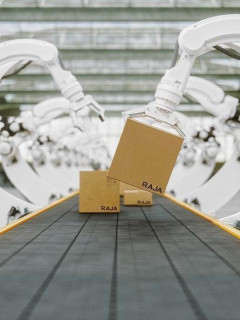As the person responsible for logistics in your company, you know that there are many small details to consider when fulfilling your customers’ orders in order to achieve maximum customer satisfaction.
Because it’s easy to forget a crucial detail, we’ve put together the 5 steps of the customer order process for you , along with some best practices for optimising logistics in your company right now.
What do consumers expect from the sales order process?
It’s no secret that your customers are becoming more demanding in their expectations of the companies from which they buy products and services. Whether you are a small business or have to manage a large number of orders, customer service should be at the heart of your logistics strategy.
So keep the following rules in mind:
- Beresponsive. The delivery of ordered products must be fast and efficient, as well as the response to possible questions from your customers before and after delivery.
- Give the customer visibility throughout the ordering process, from the availability of products in stock to the tracking of their package.
- Put flexibility at the heart of your processes. You need to offer your customers real flexibility in the delivery methods and times they can choose from, as well as potential refunds for returned products.
- Give them the best customer experience. Enrich your customers’ experience of your brand by serving them to the best of your ability, and by demonstrating your values at every stage of your supply chain.
Ready to take on these challenges?
How can you optimise the 6 steps of your sales order processing?
Find out now about the 6 key steps your order processing should follow, as well as smart tips on how to optimise them from A to Z.
Step #1: The sales order
It all starts when the customer places an order. This is when the order management process starts: the customer receives his order form and the information that allows him to follow the progress of his order.
Although this phase may appear to be the simplest for logistics, it is in fact increasingly complex to manage, as sales channels have diversified over time. Companies that offer omnichannel ordering (in-store, on the company’s e-commerce site, etc.) must therefore put in place a genuine omnichannel logistics strategy.
Tips for optimising this stage:
- Make sure you have up-to-date stocks on all your sales channels, before each order. The idea is to avoid disappointing your customers by announcing a stock shortage after the fact. So plan to replenish your stock in time, thanks to a regular supplier order.
- If you manage e-commerce logistics, make sure you highlight the general sales conditions, as well as the delivery and return conditions for your products. These are all selling points for customers who need to be reassured when shopping online.
If you manage omnichannel logistics, implement a WMS(Warehouse Management System) to have a 360° view of your optimised stock management in real time across all your sales channels. This software for managing the customer order process can also be beneficial for smaller companies, if they have to manage a large number of orders every day.
Find out more about what you need to know to start your logistics WMS integration project.
Step #2: Product picking
This second stage heralds the start of the order picking phase. Firstly, the operators are busy obtaining the order forms to be followed, then picking up the products in the warehouse and placing them on the packing station.
Note that smaller companies, which prepare all orders one after the other, often combine the picking and packing phases so that one and the same operator manages each order from start to finish.
Tips for optimising this stage:
- Set up your WMS so that it produces your picking lists automatically, in order to avoid the order errors that can occur when these lists are created manually.
- If you manage a large warehouse, set up an optimised picking method, associated with your stock management method. This allows you to limit the unnecessary physical flow of operators in the warehouse, and above all, to gain in efficiency, to serve the customer as quickly as possible.
Need to optimise your picking phase? Check out our guide to logistics picking to get all the tips you need to do so.
Step #3: Packing the order
Once the products have been picked in the warehouse, it is time to pack them. The aim of this order picking phase is to pack quickly and well, to ensure that the order is processed quickly, but that the customer experience is always looked after.
To do this, you need to make sure that you have selected the ideal packaging for your business, which is both protective and attractive.
Tips for optimising this step:
- Organise the packing stations so that they are as ergonomic and practical as possible for your order pickers. This will require preparing all the tools they need, but also ensuring maximum comfort, thanks in particular to sit-stand stools or anti-fatigue mats. To find out more, read here how to choose your packing table or packing station.
- Take care whenunboxing your packaging. Make sure that the packaging you choose is easy to open (with tear-off strips, for example). You can also personalise them with your brand colours to make receiving your orders recognisable and attractive. Also, take care of the invoices you put in them, by inserting them in an attractive pocket. The little extra? Include small goodies in the package that will make all the difference. Take the time to find out how to improve theunboxing of your packaging here.
- Makesure your packaging is environmentally friendly. Avoid over-packaging at all costs, which customers see as a synonym for environmentally unfriendly logistics practices. And to choose environmentally friendly packaging that ensures a good brand image, follow the 5Rs of packaging.
- For your express or international deliveries, make sure you also optimise the volumetric weight of your packaging, to limit invoicing by volume. Many service providers invoice for these shipments according to this criterion. To find out more, read our guide to volumetric weight here.
Step #4: Shipping the order
This is when the order is shipped: your automation system sends a confirmation to the recipient, and you hand the package over to the carrier, who will deliver it on time.
The tip for optimising this stage:
- Afew days after this stage, plan to send a customer satisfaction questionnaire. This will allow you to collect customer opinions (which you can use as social proof to convince other customers on your communication media), and to obtain constructive feedback to optimise your customer order process afterwards.
Step #5: Product delivery
This stage of the customer order process is a key moment to ensure an optimal customer experience for your company. Your customers expect real responsiveness and flexibility from the transport provider you have hired, so you should be very careful in selecting them.
Tips for optimising this stage:
- Offer your customers several modes of transport, by working with different transporters who offer click-and-collect, drive-through, home delivery or even delivery to a Relay Point.
- Check that they have a tracking system that allows you to follow the parcels in real time
- Ensure that your delivery solutions are environmentally friendly, especially for last mile delivery, which is the most polluting
- Offer 48-hour delivery if possible, to satisfy the customers who are in a hurry to receive their order.
Step #6: Managing customer returns
The last phase of your customer order process is the management of product returns. Although this can be a logistics process in its own right, it is important to consider it as an integral part of the process, so as not to neglect it. It can be a major expense for you – and more importantly, a crucial step in the customer journey you offer to consumers.
Tips for optimising this stage:
- Develop a well thought-out customer returns policy. You must answer all the potential questions your customers may have: time limits and reasons for accepted returns, conditions for taking back products depending on their condition, provision of a pre-paid return label, etc.
- Use return or reusable packaging for your e-commerce orders, to make it easier for customers to return their goods. This packaging is designed to protect the products during several consecutive shipments, so that the consumer does not have to repackage the goods himself.
Want to know more about this topic? Our guide to customer returns will help you in your thinking.
It is up to you to implement all of these optimisation options now, so that you can ensure that your company’s customer order processing is on the up and up!
















